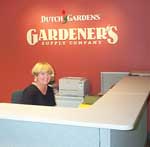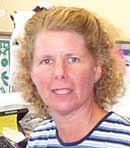In June 2003, Gardener’s Supply Company (GSC) celebrated its twentieth year in business by deciding to remodel its corporate headquarters in Burlington, VT. The project marked the arrival of an upstart cataloger into the ranks of full-spectrum direct marketers with strong sales channels in e-commerce, retail, and live goods. The company has even started to answer the phone with the phrase “America’s Gardening Resource” to help make the point.
Like many growing companies, GSC had put off making improvements to its facility. The pressures of growth and the costs of continued success had made such investments out of the question. However, the anniversary capped a long string of profitable years, and the advent of rock-bottom interest rates finally convinced the firm to take the plunge. And when GSC finished planning and designing, it had a scheme that touched every square foot of real estate, inside and out, with new systems, finishes, and materials.

IF IT AIN’T BROKE, DON’T FIX IT And if it is broke, fix it and use it again. Bootstrapping corporate cultures are hard to convince that investing in environmental amenities of any kind is worth the cash required. In addition, GSC conducts business as an ESOP (employee stock options plan), which makes each of the approximately one hundred and sixty full-time employee residents of this building a watchful, parsimonious owner.
As a result, every expenditure is subject to vigorous debate, and any investment in facilities tends to be viewed with caution and doubt. It should come as no surprise, therefore, that by the time GSC summoned the reluctant will to remodel its building, it chose to do its own construction, or “self-perform.” This turned out to be a successful attempt to save money and increase in-house control over construction logistics.
KICKING THE ANT HILL The corporate headquarters contains all of the predictable “front-of-house” units of the contemporary cataloger. (The distribution center moved out to a different location about ten years ago.)
The most populous department is a customer contact center (CCC) that consists of employees with titles as varied as “telephone sales representatives,” “Net reps,” “customer service staff,” “trainers,” and “supervisors,” along with one office operations manager, Tena Pirelli. This population peaks twice a year (holiday and spring) with the addition of temporary employees, which can bring the total up to 115.
By the time the design was complete, it was clear that every square foot of the nearly 56,650-sq.-ft. building would be reconstructed, and that every employee would be asked to move to a temporary location at least once, if not twice. Except the CCC.
The project team based its whole approach on choosing the right moment to move the CCC (after Jan. 1, when the bulge of holiday ordering is exhausted) and to ensure that the voices of GSC moved in a structured sequence to prevent the loss of a single incoming order.
Due to the complexities of relocation, a three-phase, nine-month venture was initiated in August 2003, featuring a “lights-on” date for the CCC in January 2004. Such focus on the CCC may seem like the tail wagging the dog, but when your company’s income and customers’ satisfaction depend upon a smooth response to a request to purchase, there is no Plan B.
SUCCESSFUL TRANSPARENCY, OR WHAT THE CUSTOMER CANNOT SEE With great ceremony and deep breathing, GSC CEO/founder Will Raap, president Jim Feinson, COO Cindy Turcot, and project director David King initiated the project by drafting a memo titled “Success Defined.” The first two objectives of the seven that made the cut read:
-
“Project completed with no physical injury to workers or tenants”;
-
“Project completed without any operational shutdowns for GSC.”
Loosely translated, the message is clear: Let’s not hurt anybody and let’s not get in our customers’ way. If we do either, we will have failed.
DESCRIBING THE OBJECTIVE The GSC project provided a planning umbrella under which the customer contact center relocation acted as the linchpin. Objectives for the CCC included the following:
-
Create a duplicate upgraded and enlarged facility on the far side of a temporary partition.
-
Move into the new facility in a phased manner, allowing the customer service agents to pick up their phones and computers and shift to the new stations ready for them. (Furniture panels and equipment were retained and reused, with some minor new purchases made to account for growth.)
-
Provide better organizational layout (enhanced access to management and support), more personal comfort (HVAC and lighting), and greater operational efficiency (product gallery, training rooms, toilet facilities, and IT support).
The planning required to achieve these objectives was significant. A planning consultant and old friend of Gardener’s Supply, Judith Harris, was retained for several months on a nearly full-time basis to interview team leaders, create furniture layouts, design support facilities, interface with the project architect, and report results to the management team. This process took fully as long as the projected construction time of six months.
THE TICKING MANAGEMENT CLOCK Project clocks operate in several time zones — planning time, lead times, management time, and overtime.
For its part, the management team met weekly with the design consultant team for up to three hours, an obligation that persisted throughout construction. Topics on the agenda included costs, budgets, changes, schedules, and logistics.
Three additional people rounded out the implementation team. All of them were on GSC’s payroll, and dedicated most of their weekly efforts to the project.

Ellen Desjardin (coincidentally, that’s French for “of the garden”!) began her involvement with this project with the title of office manager, but quickly became more of an “occupant advocate.” She was every GSC employee’s point of contact for questions, complaints, and suggestions. She also was responsible for purchasing required furniture and equipment not already financed under the project budget.
The IT department assigned John Wallagory to the CCC project on a full-time basis to help design, manage, and implement the extensive reconfiguration of cables, data closets, and computer room facilities.
David King, project director, was brought in as a full-time consultant to handle the tasks of acquiring, managing, and inspecting the work of the nearly thirty subcontractors hired to install the fixtures. He was also responsible for creating and managing the project budget, disbursing the payments, and interfacing with the personnel from the bank.
In the first phase of the project, work focused primarily upon the relocation of the CCC. Implementation started in August and ended in early February. The numbers below prorate the efforts of the designated employees to reflect the work they invested in relocating the CCC.
Jim Feinson, president, 2-4 hours/week, 9 months
Cindy Turcot, COO, 4-6 hours/week, 9 months
Judith Harris, planning consultant, 30-35 hours/week, 9 months
Ellen Desjardin, office manager, 30 hours/week, 6 months
John Wallagory, IT, 40-50 hours/week, 6 months
David King, project director, 40-60 hours/week, 8 months
WHAT AREN’T YOU DOING? These statistics represent the direct costs of salary, overtime, and benefits. Indirect costs are harder to define, but no less real. They include all of the deferred tasks that the employees involved in the CCC relocation would otherwise be managing. Special projects like this one are highly disruptive and should be recognized as such. Judith and David were hired specifically for this work, but Jim, Cindy, Ellen, and John had to find ways to cram these obligations into schedules that were already full.
Finally, office operations manager Tena Pirelli and her staff of managers and team leaders were also burdened with design meetings and reviews. While more difficult to quantify, such activities must be considered time-consuming distractions for these employees.
Note: If you are calculating the potential impact of these issues on your company, multiply your final hours-worked estimate by 1.2 to create a 20% “contingency cushion” of anticipated cost.
THOSE NOT-SO-SOFT COSTS Remodeling projects are the most difficult to predict and control. There are surprises lingering behind every partition, and realities often do not match your expectations. This can cost time and money when you can least afford them, and it requires that you investigate such potentially troublesome concealed conditions beforehand, whenever possible.
GSC wisely decided to acquire professional help, but only when it was needed. This required a wide array of consulting agreements with service providers that agreed to limited “scopes of work” and a cooperative approach to project design.
The retained team of consultants for this project included:
Architects (Scott + Partners Inc. and John Anderson Studio Inc.)
Landscape architect (T. J. Boyle and Associates)
Structural engineer (Engineering Ventures Inc.)
Civil engineer (Civil Engineering Associates)
Electrical engineer (Kirick Engineering Associates)
Mechanical systems consulting (Novus Energy LLC)
Project estimator (Erickson Consulting LLC)
Project coordination services (Harris & Harris Consulting Inc.)
By creating their own programming and purchasing only those services required under specific, targeted agreements, GSC was able to keep professional fees for this project under 8% of the project cost, and to assemble bid documents in an impressive 12 weeks.
By adopting this logistical approach, GSC conformed to its cultural habits of saving money (an estimated savings of 7% on professional fees alone) and exerting maximum control over the actual implementation.
COLD HARD CASH The cost of transplanting Gardener’s Supply Company’s customer contact center can be calculated by adding its construction costs to attributable soft costs and management expense (see above) and then dividing the total by the number of permanent staff members (115) who were accommodated by the design. This provides us with a cost-per-employee unit of expense that is comparable to other examples of the same type of project.
The number in this case comes out to slightly under $14,000 per CCC staff member. This level of “bang for the buck” compares favorably with the estimated costs of renovating existing buildings for a call center that this author last calculated in 2001 as being worth between $19,000 and $29,000 per staffer. (See “All in the Family,” Operations & Fulfillment, May 2001.)
This startling economy can be attributed to three separate characteristics of the GSC team members’ approach:
-
They “self-performed” as their own general contractor, thus saving an estimated 23%, or $3,220 per staffer, in project expense.
-
They relocated existing furnishings, phones, and computers, buying only those items required to accommodate predicted growth.
-
They exercised GSC-style caution and planned every move in advance to prevent the expenses that are associated with surprise and delay.
And as a first-time general contractor, they delivered an injury-free project, on time and under budget. Not bad for a bunch of employee/owner/gardeners, I must say!
Stephen Harris is principal of Harris & Harris Consulting, based in Lincoln, VT. He can be reached at (602) 453-6384.
